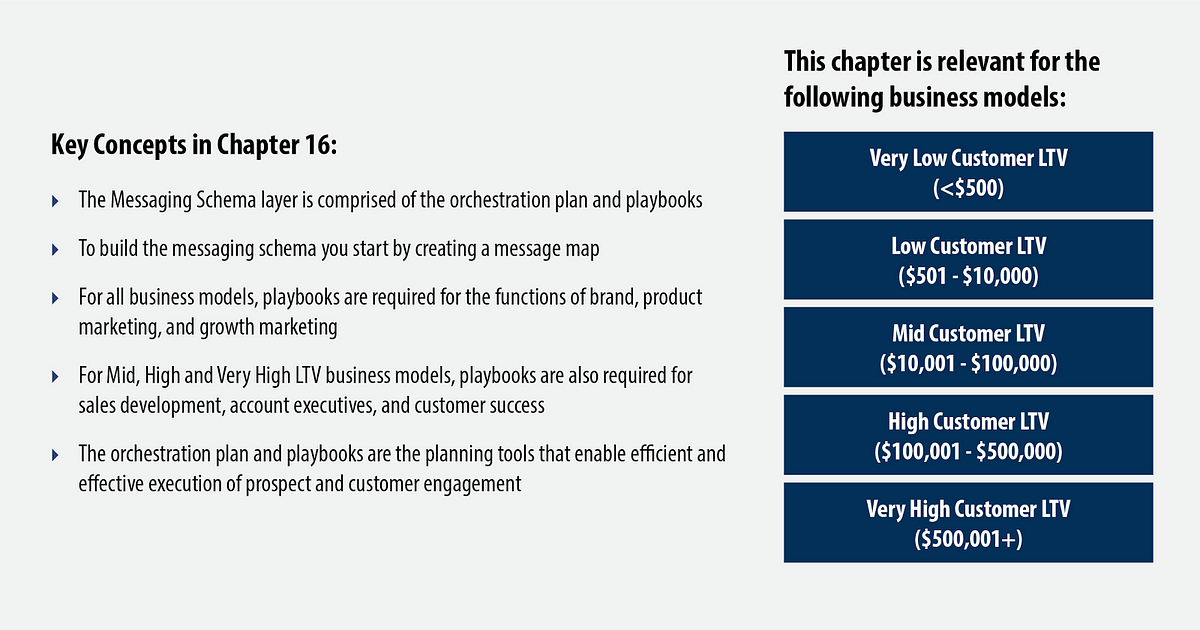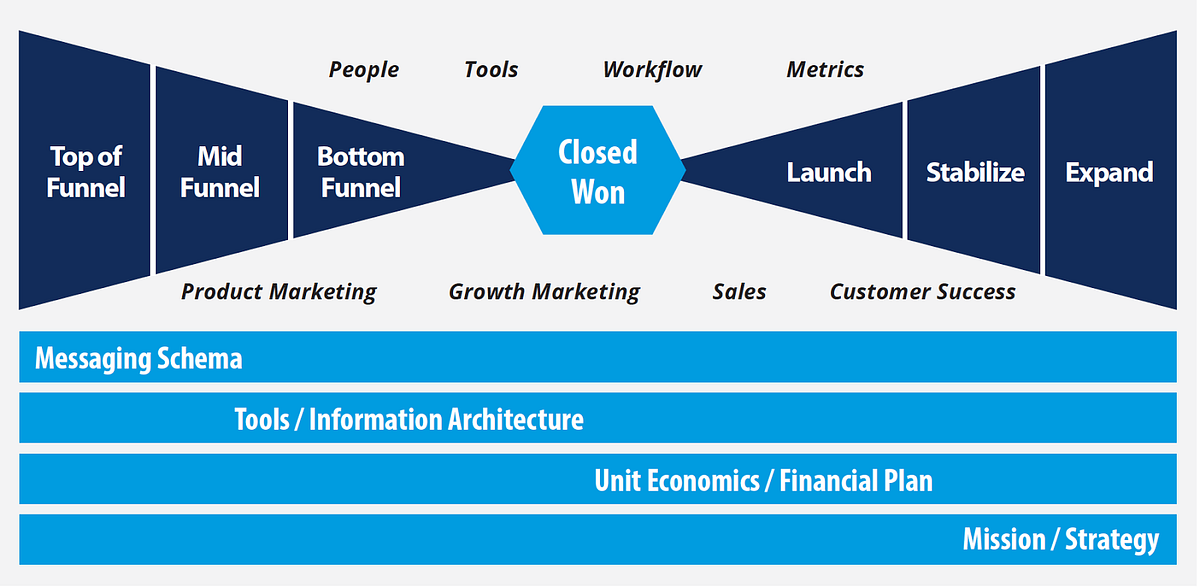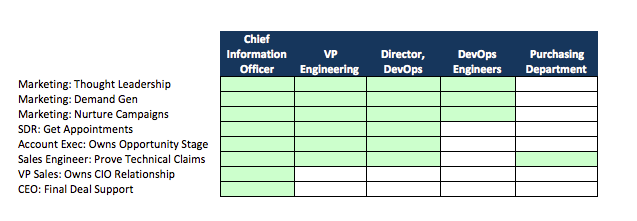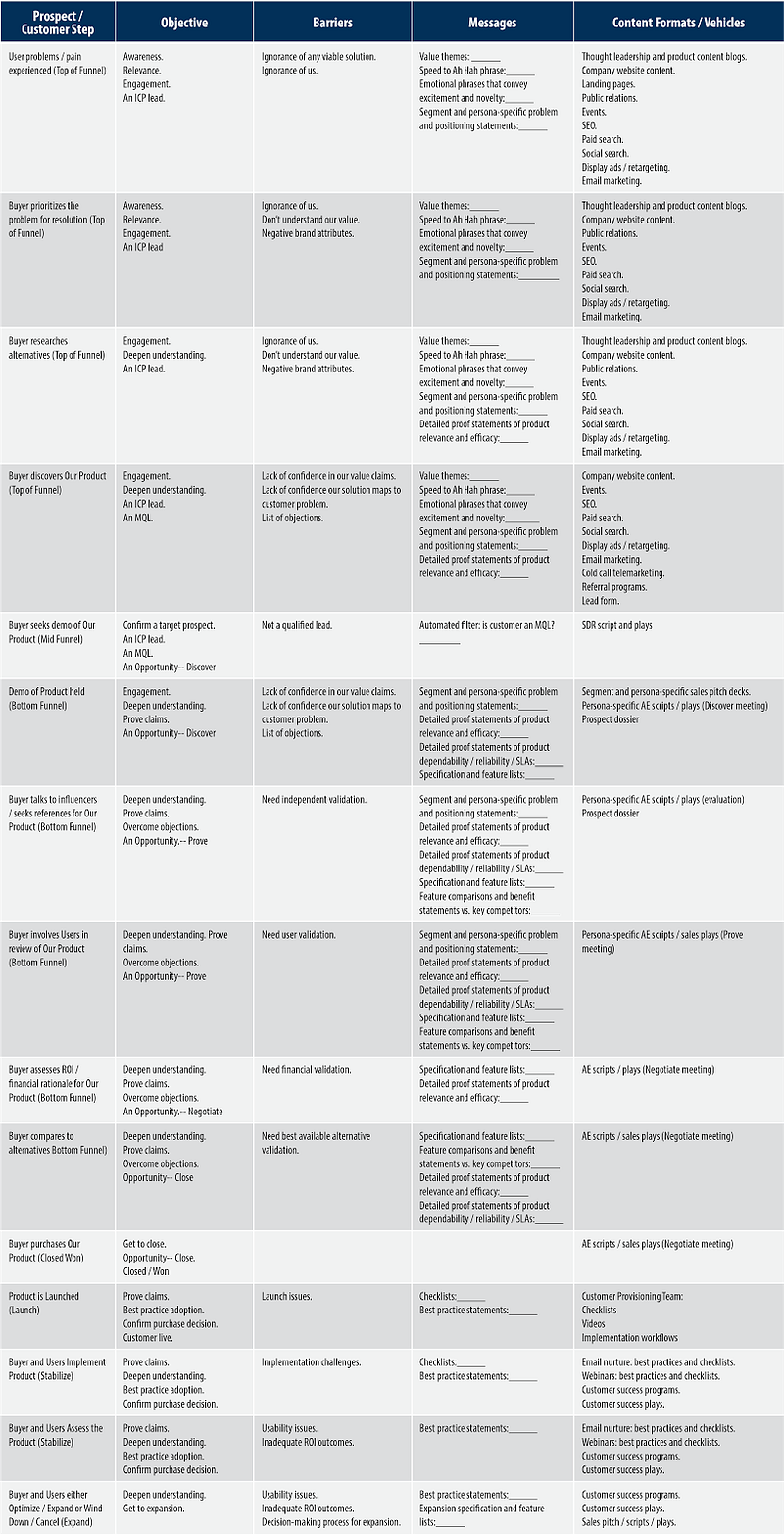Message + method = momentum.

When it comes to chasing revenue, CEOs often spend all their time in execution mode, without dedicating any time to foundation building. This is a mistake. Time wasted delivering poorly considered messages to the wrong people, at the wrong time, in an irrational sequence, leads to disappointing results. If anything is clear by now in reading this book, it’s that research, planning, and thoughtful design are essential to effective execution of the revenue engine.
Nowhere is this truer than in the Messaging Schema, the final foundational layer of the revenue engine framework.

By now you have:
- Defined your mission and vision
- Built a robust segmentation scheme
- Chosen your top priority segments, the ideal customer profile (ICP), and buyer and user personas specific to each segment
- Validated a clear value proposition
- Verified competitive positioning statements
- Developed your brand identity (brand as product / company / person / symbol) and articulated clear “vision lock,” “conviction lock,” and “advocacy lock” statements (as captured in your brand identity document)
- Mapped the prospect and customer journeys for buyer and user personas
- Determined your channel choices and weightings
- Defined and living within the LTV / CAC constraints of your revenue model
- Built a board-approved financial plan, with specific revenue objectives and a marketing and sales budget (both labor and non-labor)
- Constructed your tools and information architecture
Now you’re ready to create your messaging schema — the orchestration plan and playbooks that drive all messaging.

Orchestration Plan
Your orchestration plan is of supreme importance. In this plan, you design the journey you hope to deliver to your target prospect (from Top of Funnel to Mid to Bottom domains in the Bow Tie), and the journey of your customer (from Closed Won domain to Launch / Stabilize / Expand domains in the Bow Tie).
For a Very Low LTV business model, the prospect is a person, and the journey is fully digital. For a Very High LTV business model, the prospect is an account, multiple people are prospect contacts and must be engaged (e.g., buyers, users, gatekeepers, and influencers), and the journey is multidimensional. Regardless of prospect type, the goal is to continuously increase engagement. This begins by defining the key players inside a target account and determining who on your team owns the relationship. In the High or Very High LTV scenario, it’s multidimensional, with many-to-many engagement required. Here’s an example for a business selling a development platform to enterprise customers:

With the primary many-to-many relationships determined, your orchestration plan then maps the experience you seek to deliver to each of these key players on the prospect and customer journey, as follows:

Source: Scott Albro, CEO of TOPO¹
In this example, a prospect receives a sequence of account-based ads, customized content, a custom webinar, physical promotion, deep research, a personal outreach, an executive outreach, a physical event or trade show, deep discovery, a personalized pitch, a custom demo, more ads, a custom workshop, and content-based selling. After the purchase decision, the customer receives a white glove trial, a custom proposal and business case, hands-on on-boarding, account insights, customer events, use case campaigns, more personalized outreach, and a customer workshop.
Note that along this journey from prospect to customer, contacts occur in a variety of ways with stage-specific messaging.
The various touch points are designed to move the prospect steadily from Top of Funnel domain to Mid to Bottom domains, and then to move the new customer through the domains of Launch, Stabilize, to Expand.
If the orchestration plan is driven by touch points, the touch points themselves are driven by messaging. It’s helpful to complete a message map to get the stage-specific messaging right.
A message map is a table with the following columns:
- Prospect / customer step
- Objective
- Barriers
- Messages
- Content formats / vehicles
It looks something like this:

With your orchestration plan and message map complete, you can now turn to the creation of playbooks.
The Purpose of Playbooks
Playbooks guide day to day actions for your team. If your business has a Very Low or Low LTV business model, there will be three playbooks: brand marketing, product marketing, and growth marketing. If your business model is from Mid LTV to Very High LTV, you will add three more playbooks for sales development, account executive, and customer success. Your playbooks rest on the foundations of segmentation scheme, brand identity, message map, and orchestration plan:

Your brand identity document (see Chapter 7 — Brand Identity), with its theme statements and product-specific statements, anchors all messaging. But messages will vary by prospect and customer stage. They will be presented in diverse vehicles and formats. They must be communicated in time and space. And they must be generated and transmitted by different functional team members. So it is the purpose of each playbook to provide each functional team (whether brand, product marketing, growth marketing, sales development, account execs, or customer success) a game plan that coordinates:
Bow Tie domain
- Top of Funnel
- Mid Funnel
- Bottom Funnel
- Launch
- Stabilize
- Expand
Message vehicle
- Media
- Company website
- SEO / landing pages
- SEM
- Advertising / retargeting
- Trade shows
- Workshops
- SDRs
- AEs
Message format
- Email templates
- Call scripts
- Blog
- Video
- Slideshow
- Articles
- Press releases
- Power points
- Demo platform
- Collateral materials
Time
- Prospect engagement steps and messaging rules
- Editorial calendar
Brand Playbook
The brand playbook includes the style guide. The style guide presents your brand visual expression comprised of your brand architecture, your brand personality, and brand symbols (logo, slogans, iconography, typography, color palette, etc.). It is followed rigorously in all messaging.
The brand playbook also lists the top priority projects that will be completed (this quarter / this year) to improve brand visual expression. The redesign of collateral materials, the website, or other brand assets are good examples.
Finally, in larger companies, the brand playbook includes the plan for any brand campaigns. Brand campaigns are usually big-budget multimedia campaigns with the purpose being to increase brand awareness and brand equity. They live by the motto, “go big or go home.” A brand campaign would include the budget, multimedia content creation plan, and the media plan.
Product Marketing Playbook
Product marketing is all about content. The purpose of the product marketing playbook is to provide direction on content creation — the content itself, the format, and the timing. A product marketing playbook might include:
- Value proposition
- Competitive positioning statements
- Theme based and product based value statements for Top, Mid, and Bottom Funnel Domains
- Top of Funnel domain: content production plan by vehicle and format
- Mid and Bottom Funnel domains: the pitch deck; the demo; supporting materials
- Launch / Stabilize / Expand domains: best practice checklists, case studies, and content production plan by vehicle and format
- Company website plan
- Community and partner plan
- Content publication calendar
- PR calendar
- Webinar calendar
- Trade show calendar
Growth Marketing Playbook
Growth marketing exists to execute campaigns and optimize conversion along the domains of the Bow Tie (i.e., from Top of Funnel to Mid Funnel to Bottom Funnel to Launch, Stabilize, and Expand). The growth marketer’s work at the Top of the Funnel domain involves using a diversity of messaging vehicles and leveraging a several different message formats in a continuous test / iterate / optimize mode. In contrast, growth marketing work in the Mid and Bottom Funnel domains and in the Launch, Stabilize, and Expand domains is structured more formally. Email nurture campaigns for all prospect and customer use case scenarios are designed, built, and maintained.
The role of the growth marketing playbook is to guide the team in executing this diverse plan. It might include:
- Monthly budget; allocation by product
- Reach and conversion objectives at every step
- Data management plan: data structure in the database and how data will be tagged, de-duped, and accurately maintained
- Vendors / tools plan (review of existing; new ones to consider; plan to leverage each)
- Value proposition
- Competitive positioning statements
- Key theme based and product based value statements
- Top of Funnel domain campaign plans: SEO, SEM, digital advertising / retargeting, email
- Testing plan: how campaigns will be tested, iterated and optimized
- Prospect email nurture workflow (with templates) supporting the sales development process and the process from Opportunity stage to Closed Won stage for all use case permutations
- Customer email nurture workflow (with templates) supporting the entire post-sale customer experience for all use case permutations
Sales Development Playbook
For those companies with Mid, High or Very High LTV business models, perhaps the most critical — and under-appreciated — function in the revenue engine is sales development. Human engagement with prospects begins here. Therefore, the efficiency and effectiveness of this engagement are vital.
Sales development reps (SDRs) exist to determine whether leads are qualified (regarding budget, authority, need, and timing — BANT) and whether qualified prospects are ready to engage seriously.
In a well-orchestrated plan, there are a wide variety of prospect touch points such as ads, emails, search results, and trade show connects. The first human connection is usually made by a sales development rep (SDR) in the Mid Funnel domain on the Bow Tie schema. Whether SDRs are following up on a marketing qualified lead (MQL) or cold-calling into targeted prospects, the goal is to create a sales qualified lead (SQL). This SQL is turned over to an account exec who reconfirms budget, authority, need and timing (BANT), and it then becomes a sales accepted lead (SAL).
The SDR playbook is used by management and the SDRs themselves to conform to best practice in day-to-day work. This playbook includes:
- Overview of the role
- Overview of the orchestration plan
- Overview of SDR workflow
- ICP description: the key attributes
- Buyer, influencer, and user persona descriptions
- Buyer, influencer and user value propositions and use case stories
- Qualifying questions
- The AE handoff
- SAL criteria
- SDR multi-day, multi-touch campaign specifics, and SDR actions at each step
- Instructions for updating the account and contact status in CRM
- Scripts for voicemails and live calls
- Scripts for emails and guidance on custom content blocks
- Objection-handling plays
- SDR standards and expectations
- The SDR daily calendar
Account Executive Playbook
Given the increased cost of an account executive (AE) as compared to an SDR, AE time is spent in the Bottom Funnel domain. The Bottom Funnel journey is a series of stages from opportunity to closed won — a journey that involves four steps (discover, prove, negotiate, and close). The AE playbook provides the process tools and messaging to help AEs manage their workload and optimize conversion.
The AE playbook includes:
- Description of ICP
- Description of the buyer personas and associated messaging
- Value proposition
- Competitive positioning
- Theme based and product based value statements
- Case study examples
- Competitive feature comparison lists
- Objection handling talking points
- Product feature details
- Product implementation details
- Pitch deck and demo plan (may be variations by segment or product)
- Detailed review of the sales process, including definitions for MQL and SAL
- Discover step: the objective and meeting plan; plays (such as “map the buying process” play)
- Prove step: the objective and meeting plan; plays (such as “proof of value” or “champion enablement” play)
- Propose step: the objective and meeting plan; plays (such as “the ROI” play)
- Close step: the objective and meeting plan; plays (such as “due diligence” or “onboarding” plays)
- Renewal: the objective and meeting plan; plays
- Expansion: the objective and meeting plan; plays
Customer Success Playbook
The customer success function touches three Bow Tie domains: Launch, Stabilize, and Expand. For many products, the successful technical launch of a customer requires completing a series of steps, usually in coordination with the customer. Once technical launch has occurred, user launch comes next — characterized by the achievement of a minimum frequency of use, breadth of feature utilization, and / or number of users. From that point, stabilization occurs when use, utilization, and number of users are consistently at acceptable levels and when the expected benefits of the solution are achieved reliably.
The customer success function, then, is comprised of both programs (consistently repeated work projects that all customers receive) and plays (actions that are taken in response to signals, such as “below minimum use threshold”). These programs and plays are often technical and tactical in nature. Regardless, messaging remains critically important.
With every on-boarding step, FAQ, or intervention “play,” your messaging schema must be brand true.
Given these functional requirements, the playbook will include such programs and plays as:
- The customer success launch: handoff meeting from the sales team to the customer success team
- The technical launch program: on-boarding system manual, step-by-step on-boarding guide, integration checklist, testing procedures
- The user launch program: user enablement plan, best practices, FAQ’s
- 90/180/360 day program: engagement plan, user webinars, best practice standards, objectives, and outcome metrics
- Feature adoption and usage program: engagement plan
- Play: too few users
- Play: too low rates of utilization
- Play: too low feature adoption
- Play: account suffers from drop in utilization
- Play: users affected by service outage or SLA breach
- Play: customer cancels
- Play: customer inquires about up-sell / cross-sell opportunities
- Play: customer records very high customer satisfaction (NPS) score
Your messaging schema will vary depending on your business model and target customer. How it is applied will vary by channel. Of course, for direct selling, you have full control. If you have resellers or OEMs as partners, then you will need to develop your messaging schema in collaboration with your partners and seek agreement to inspect and continuously improve it.
Messaging Schema is the final foundational layer of the revenue engine. With a fully tested and validated messaging schema, you are now ready to execute the Bow Tie journey.
Unleash your greatness.
. . .
Notes
- Scott Albro, CEO of TOPO. “Account-Based Everything.” San Francisco, CA. September 2016. Private presentation to CEO Quest members.
. . .
If you would like more insight into scaling your revenue engine and building a great tech startup, please visit our website CEOQuest.com, or connect with us on LinkedIn or Twitter.

